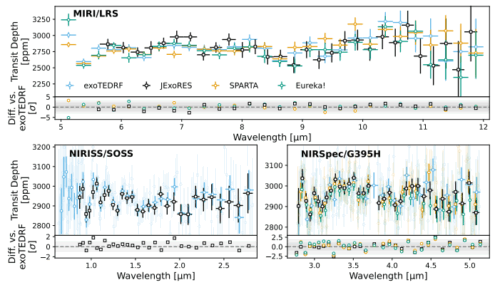2025-05-22 シカゴ大学(UChicago)
<関連情報>
- https://news.uchicago.edu/story/possible-sign-life-deep-space-faces-new-doubts
- https://arxiv.org/abs/2505.13407
K2-18の大気中のDMSとDMDSの証拠が不十分 b. JWST NIRISS、NIRSpec、MIRI観測の共同分析から Insufficient evidence for DMS and DMDS in the atmosphere of K2-18 b. From a joint analysis of JWST NIRISS, NIRSpec, and MIRI observations
R. Luque, C. Piaulet-Ghorayeb, M. Radica, Q. Xue, M. Zhang, J. L. Bean, D. Samra, M. E. Steinrueck
arXiv Submitted on 19 May 2025
DOI:https://doi.org/10.48550/arXiv.2505.13407

Abstract
Recent JWST observations of the temperate sub-Neptune K2-18 b have been interpreted as suggestive of a liquid water ocean with possible biological activity. Signatures of DMS and DMDS have been claimed in the near-infrared (using the NIRISS and NIRSpec instruments) and mid-infrared (using MIRI). However, the statistical significance of the atmospheric imprints of these potential biomarkers has yet to be quantified from a joint analysis of the entire planet spectrum. We test the robustness of the proposed DMS/DMDS detections by simultaneously modeling the NIRISS and NIRSpec observations jointly with the MIRI spectrum, considering different data reductions and modeling choices. We use three well-tested pipelines to re-reduce the JWST observations, and two retrieval codes to analyze the resulting transmission spectra as well as previously published data. Our joint analysis of the panchromatic (0.6 – 12 um) spectrum of K2-18 b finds insufficient evidence for the presence of DMS and/or DMDS in the atmosphere of the planet. Furthermore, other molecules containing methyl functional groups (e.g., ethane) with absorption bands similar to DMS/DMDS provide an equally good fit to the data. We find that any marginal preferences are the result of limiting the number of molecules considered in the model and oversensitivity to small changes between data reductions. Our results confirm that there is no statistical significance for DMS or DMDS in K2-18 b’s atmosphere. While previous works have demonstrated this on MIRI or NIRISS/NIRSpec observations alone, our analysis of the full transmission spectrum does not support claims of potential biomarkers. Using the best-fitting model including DMS/DMDS on the published data, we estimate that ~25 more MIRI transits would be needed for a 3-sigma rejection of a flat line relative to DMS/DMDS features in the planet’s mid-infrared transmission spectrum.



